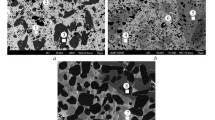Conclusions
-
1.
The optimum conditions for the preparation of a composite material of the ZrB2-SiC-C-V system by the hot-pressing method have been determined. In the system investigated a liquid phase forms in the temperature range 1900–2000°C.
-
2.
The vanadium-containing composite material was found to consist of the following phases: ZrB2, ZrC, VB2, SiC, and C.
-
3.
A study was made of the oxidation resistance of materials of the ZrB2-SiC-C, ZrB2-SiC-C-Nb, and ZrB2-SiC-C- V systems in the temperature range 1200–1800°C. The highest oxidation resistance was found to be exhibited by a material of the ZrB2-SiC-C-V system.
Similar content being viewed by others
Literature cited
L. A. Gel'fond, V. S. Dergunova, and Yu. N. Petrov, “Some properties and structure of a graphite-base composite material with zirconium diboride and silicon carbide additions,” Poroshk. Metall., No. 3, 79–83 (1976).
E. V. Clougherty, E. T. Peters, and D. Kalish, “Diboride materials, candidates for aerospace applications,” in: Materials and Processes for 70's, SAMPE, New York (1969), pp. 297–308.
Kh. P. Vainberg, “Constructional materials for high-temperature operation,” in: High-Temperature Inorganic Coatings [in Russian], Metallurgiya, Moscow (1969), pp. 144–185.
Yu. M. Zelikson, “An investigation of some characteristics of open-cycle MHD generators,” Candidate's Dissertation, Moscow (1973).
H. K. Bowen, I. W. Halloran, W. T. Petuskey, et al., “Chemical stability and degradation of MHD electrodes,” in: Direct Conversion of Thermal Energy into Electrical [Russian translation], Vol. 7–8, VINITI, Moscow (1975), pp. 39–55.
V. V. Kirillov, A. I. Rekov, Yu. M. Zelikson, et al., “Testing of the channel elements of an open-cycle MHD generator in the Temp apparatus,” in: Materials for MHD Generator Channels [in Russian], Nauka, Moscow (1969), pp. 168–179.
V. G. Nagornyi, A. S. Kotosonov, V. S. Ostrovskii, et al., Properties of Carbon-Base Constructional Materials (A Handbook) [in Russian], (V. P. Sosedov, editor), Metallurgiya, Moscow (1975).
G. V. Samsonov and K. I. Portnoi, Alloys Based on Refractory Compounds [in Russian], Oborongiz, Moscow (1961).
D. M. Kheiker and L. S. Zevin, X-Ray Diffractometry [in Russian], Gos. Izd-vo Fiz.-Mat. Lit., Moscow (1963).
C. R. Houska and B. E. Warren, “X-ray study of the graphitization of carbon black,” J. Appl. Phys.,25, 1503–1507 (1954).
A. S. Fialkov, Formation of Structure and Properties in Carbon-Graphite Materials [in Russian], Metallurgiya, Moscow (1965).
G. V. Samsonov, T. I. Serebryakova, and V. A. Neronov, Borides [in Russian], Atomizdat, Moscow (1975).
Author information
Authors and Affiliations
Additional information
Translated from Poroshkovaya Metallurgiya, No. 6(186), pp. 60–64, June, 1978.
Rights and permissions
About this article
Cite this article
Krivoshein, D.A., Maurakh, M.A., Dergunova, V.S. et al. Method of manufacture and oxidation resistance of a graphite material with zirconium diboride, silicon, and vanadium additions. Powder Metall Met Ceram 17, 460–463 (1978). https://doi.org/10.1007/BF00795802
Received:
Issue Date:
DOI: https://doi.org/10.1007/BF00795802



